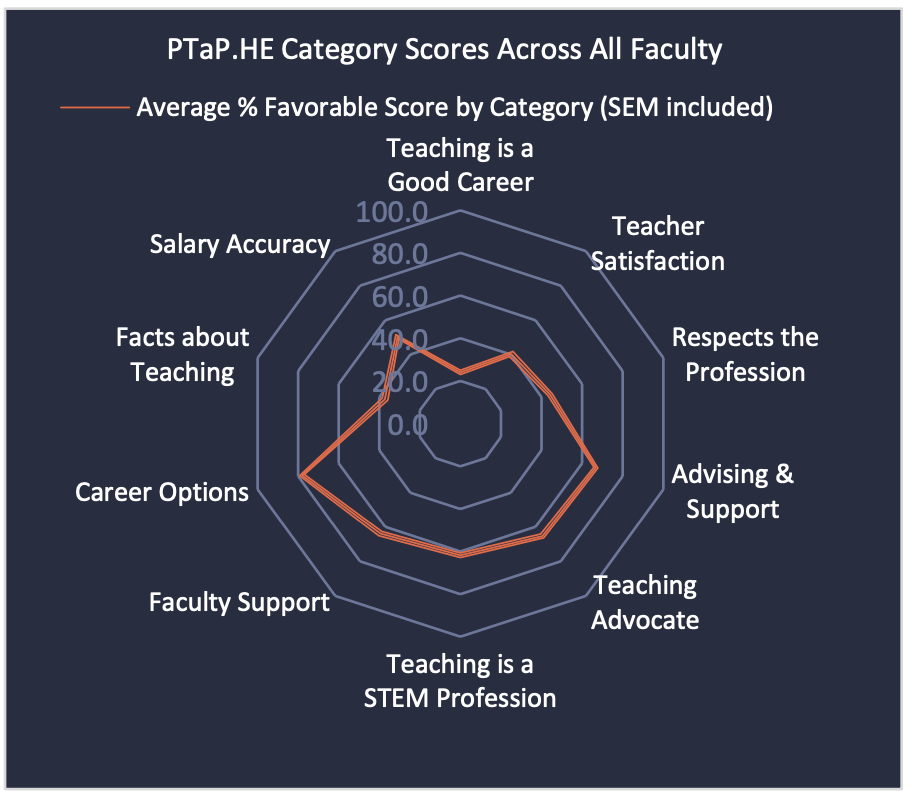Developed by Wendy K. Adams, Richard L. Pearson III, Savannah L. Logan
| Purpose | To measure faculty perceptions and attitudes about teaching. |
|---|---|
| Format | Multiple-choice, Agree/disagree |
| Duration | 8-10 min |
| Focus | Beliefs / Attitudes (Facts about Teaching, Salary, Teaching is a Good Career, Teacher Satisfaction, Respects Profession, Advising & Support, Teaching Advocate, Teaching is a STEM Profession, Faculty Support, Career Option) |
| Level | Upper-level, Intermediate, Intro college |
I think grade 7-12 math or science teaching would be an enjoyable career day-to-day.
- Strongly Disagree
- Disagree
- Neutral
- Agree
- Strongly Agree
I regularly discuss grade 7-12 math or science teaching as a career option with students.
- Strongly Disagree
- Disagree
- Neutral
- Agree
- Strongly Agree
Everything you need to know about implementing the PTaP.HE in your class.
more details
This is the second highest level of research validation, corresponding to at least 5 of the validation categories below.
Research Validation Summary
Based on Research Into:
- Student thinking
Studied Using:
- Student interviews
- Expert review
- Appropriate statistical analysis
Research Conducted:
- At multiple institutions
- By multiple research groups
- Peer-reviewed publication
The questions on the PTaP.HE were developed based on topics that are important to faculty and teacher recruiters and the questions on the PTAP. The developers identified the various ways faculty thinking can deviate from expert thinking about these topics through individual interviews and focus groups, and created a Likert-scale instrument with some open-ended survey questions to probe faculty thinking more broadly. The developers conducted validation interviews with both novices and subject experts on the survey statements, and administered the survey to faculty broadly. The performed appropriate statistical analyses of the results, including a reduced-basis factor analysis was performed to identify statistically valid underlying factors within the survey. The PTaP.HE has been given to over 500 faculty, and the results published in three peer-reviewed publications.
References
- J. Breakall, S. Logan, R. Pearson III, B. Pyper, and W. Adams, Maybe we aren’t that different after all: Faculty perceptions of grade 7-12 teaching as a career, presented at the Physics Education Research Conference 2020, Virtual Conference, 2020.
- S. Logan, J. Breakall, R. Pearson III, and W. Adams, College faculty support for grade 7-12 teaching careers: survey results and comparisons to student perceptions, presented at the Physics Education Research Conference 2020, Virtual Conference, 2020.
- R. Pearson III, S. Logan, and W. Adams, Faculty perception insights obtained from faculty interviews during the development of the Perceptions of Teaching as a Profession in Higher Education (PTaP.HE) instrument, presented at the Physics Education Research Conference 2020, Virtual Conference, 2020.
We don't have any translations of this assessment yet.
If you know of a translation that we don't have yet, or if you would like to translate this assessment, please contact us!
Download the PTaP.HE answer key.
| Typical Results |
|---|
PTaP.HE average percent favorable by category among college STEM faculty. Line thickness represents the standard error on the mean within each category (Breakall et al., 2020).
|
The most recent version of the PTaP.HE, released in 2019, is version 2a.





